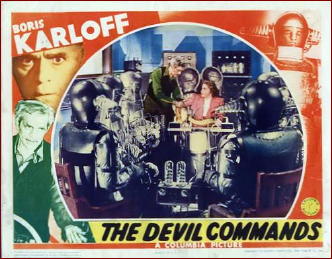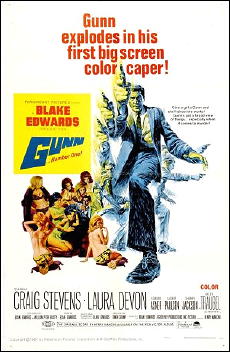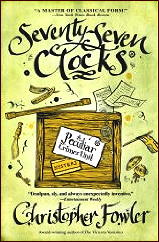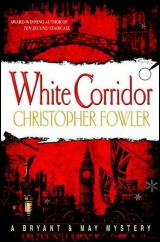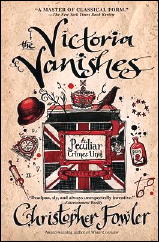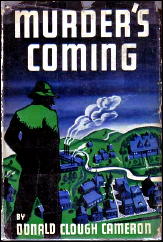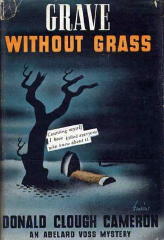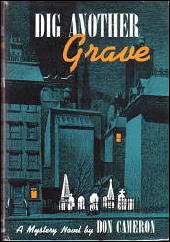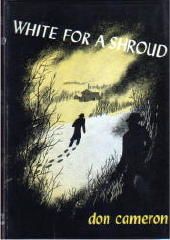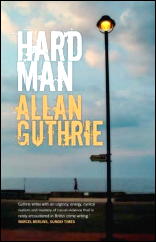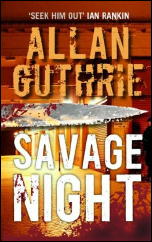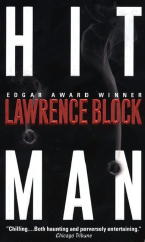April 2010
Monthly Archive
Tue 13 Apr 2010
THE DEVIL COMMANDS. Columbia Pictures, 1941. Boris Karloff, Richard Fiske, Amanda Duff, Anne Revere, Ralph Penney, Kenneth MacDonald. Based on the novel The Edge of Running Water by William Sloane. Director: Edward Dmytryk.
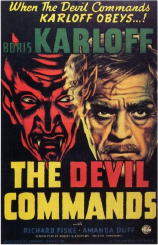
Beginning with the movie Ghost, there has been a flood of films recently dealing with the possibility of communicating with the dead, but of course movies dealing with the dead and ways with getting in touch with them are not a recent phenomenon at all, and I’m sure it was already old stuff when The Devil Commands came out.
Most of the recent movies on the subject seem to be out-and-out fantasies (Flatliners, which I haven’t seen, may be an exception), but in 1941, science was still new enough that almost anything was possible.
The Devil Commands takes the prevailing point of view, however, that there are “things no human being should know,” or at least I assume it was a prevailing point of view in 1941, when this movie came out. Boris Karloff, haggard and bereft after the death of his wife, is an archetypal “mad scientist” in this movie — a villain, but an innocent victim as well.
In terms of film style, it’s filmed in black and white, but I think there’s far more black on the screen than there is white.
As in Ghost, there is a female spiritualist (played here by Anne Revere, as opposed to Whoopi Goldberg) who, although a fake, does have some innate power in the realm of spiritualism, a power that could be tapped, if only the “experiments” were allowed to continue.
The local townsfolk are a superstitious lot, however — nothing like a few missing bodies to arouse their anger — and while every aspect of this movie is developed to perfection, there are no wild surprises, either. This is a pulp science fiction story of the 30s brought to life, an out-and-out phantom of the past, and I savored every minute of it.
— Reprinted from Zen at Work #3, November 1993, with some revisions.
Editorial Comments: Over the years Mystery*File went through many changes, including alternate titles, and Zen at Work was unfortunately one of them. Only 40 copies were made of issue number 3, which clocked in at thirty pages long, chock filled with reviews of books and movies I’d read and watched at the time.
One of the sections in this issue I called Mystery*File 35, which I’d put together but never went out to subscribers. Another section was called Fatal Quiche. (Don’t ask.) In any case, I’ve just come across my copy of it, and over the next few weeks, if not months, I’ll be treating you with reprints from it. (I won’t go through the whole set of details again. From now on I’ll simply call it M*F 35.)
As for The Devil Commands, I imagine I still have a copy — I probably taped it from American Movie Classics when the channel was still worth watching — but remember the movie, even with my review? Not at all.
And as far as coincidences go, here’s a good one. Last Sunday, two days ago, David Vineyard emailed me a copy of his review of To Walk The Night — by none other than William Sloane, who wrote the novel The Devil Commands was adapted from. Look for it soon, here on the Mystery*File blog.
Tue 13 Apr 2010
REVIEWED BY DAN STUMPF:
GUNN. Paramount, 1967. Craig Stevens (Peter Gunn), Laura Devon (Edie), Edward Asner, Albert Paulsen, Sherry Jackson, Helen Traubel (Mother), Regis Toomey. Story-screenplay-director: Blake Edwards.
Gunn is an elegantly tasteless thing, from the TV series Peter Gunn, with Craig Stevens tossing off bemused sophistication like a blonde wiggling out of a nightie. As written and directed by Blake Edwards (a variable commodity, but rather effective here) the film offers dry wit delivered with deadpan dexterity, stylish violence (including torture by racquetball) and a fine, kinky, savage wrap-up.
It also offers Sherry Jackson popping up nude in Gunn’s apartment like the cinematic equivalent of a cheap paperback. Thinking it over, I have to say her motivation for this isn’t really convincing, but as I recall seeing it at the movies, it didn’t bother me a bit. I should also put in good words for Ed Asner, who inherits the Lt. Jacoby role and plays it quite well, and a minor actress named Marion Marshall as “Daisy Jane,” a tricky part which she brings off neatly.
Tue 13 Apr 2010
A REVIEW BY RAY O’LEARY:
CHRISTOPHER FOWLER – Bryant & May on the Loose. Bantam, hardcover, November 2009; trade paperback, September 2010.
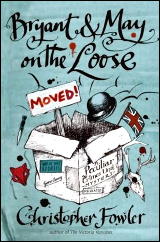
At the end of The Victoria Vanishes the Peculiar Crimes Unit was forced to close down and its members resigned in protest while its premises were turned over to another squad. Since then the elderly Inspector Bryant has been spending his time sitting around in his pajamas. Or pyjamas, if you will.
Other members have taken jobs, including Constable Colin Bimsley, working as a handyman. He’s hired by a young Arab who has taken over a Fish & Chips restaurant and is turning it into a pottery and rug store when he discovers the headless body of a man in an old freezer. Meanwhile, another ex-member of the unit, Meera Mangeshkar, out late one night sees a man dressed as a stag with horns made out of knives.
Both of these events occur in the area of London around St. Pancras Church which is being redeveloped in preparation for the 2012 Olympics. Since the murder looks like it could be the work of organized crime, it’s decided that it will be investigated by the Peculiar Crimes Unit though they will have no official connection with Scotland Yard and will be housed in a dilapidated old warehouse in the area. Before the case is over there will be four more victims of the killer including a member of the Unit.
Another very enjoyable adventure of the Peculiar Crimes Unit that manages to blend history, mythology, corporate crime and even the Beatles into the tale.
The Bryant and May series —
1. Full Dark House (2003)
2. The Water Room (2004)
3. Seventy-Seven Clocks (2005)
4. Ten Second Staircase (2006)
5. White Corridor (2007)
6. The Victoria Vanishes (2008)
7. Bryant & May on the Loose (2009)
8. Off the Rails (2010)
Mon 12 Apr 2010
DONALD CLOUGH CAMERON – Death at Her Elbow. Henry Holt; hardcover; 1940. Paperback reprint: Green Dragon #20, digest-sized, 1945 (abridged).
I don’t know about you, but until I read this book, Donald Clough Cameron was only a name to me. Using Hubin’s Revised Crime Fiction IV as a guide, here’s a list of the mysteries he wrote:
* Murder’s Coming. Holt, 1939.
Death at Her Elbow. Holt, 1940.
* Grave Without Grass. Holt, 1940.
* And So He Had to Die. Holt, 1941.
Dig Another Grave. Mystery House, 1946.
White for a Shroud. Mystery House, 1947.
Those marked with a [*] are cases handled by one Abelard Voss, about whom at the moment I can tell you nothing. I did find an old Dunn & Powell’s mystery catalogue that contained the first two in jacket, the first for $175, the second for $75, but without spending the money, assuming the books were still available, that told me nothing more about Abelard Voss than I knew before. Except that Abelard Voss is a neat name for a detective.
Even the digest 1940s paperbacks are hard to come by, but they aren’t likely to cost you more than $10 to $20 each, if you were interested.
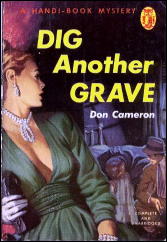
[At which point a light finally goes on in my head, and a small amount of time elapses here while I go rummaging around in some stacks of books I bought at the most recent New York City paperback show.]
And guess what. I’ve just discovered I own a copy of the aforementioned softcover version of Grave Without Grass, and inside the front cover is this description of Abelard Voss: “a unique young criminologist with the mind of a philosophic bloodhound.” Without reading further, he sounds like perhaps a young Philo Vance, and it only set me back a paltry $2.00 to obtain it.
But surely I digress. The detective in the one I did read, and which this review is nominally about, Death at Her Elbow, is Lieutenant Peter Gore, of the New York City homicide bureau. That’s mostly incidental, though, as the book focuses more on the actions of Miss Ann Potter and her at-arm’s-length boy friend and suitor, Alec Hunter, after her former fiance Paul Buell is found murdered in her apartment.
It’s one of those stories, in other words, in which each tries to confess to protect the other, and to clear themselves, they’re forced to solve the murder, with or without the assistance of the police.
Quoting from pages 110-111:
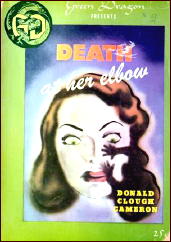
She stopped, aware too late of the direction in which her fierce defense of Alec was leading. She looked suspiciously at Gore, but his lids had dropped so far they hid his eyes completely.
“It doesn’t matter, anyway,” she said. “They didn’t meet. Alec didn’t know Buell was around till after Buell had been killed.”
“By whom, Miss Potter?”
“Heavens, I’m not a detective. How should I know?”
“Who besides Hunter might have wanted to kill him?”
And here’s Gore some more, from page 115, still taking to Ann:
“My judgment tells me that if Hunter did this killing — and a lot of my men think he did — his weakest spot is the girl he’s in love with. He might have all the guts in the world when it comes to bluffing on his own account, but not when he thinks you’re in danger. I gave him a song and dance about you because I wanted to shake him in his shoes. He shook plenty. You don’t like it and he doesn’t like it, but if he’s innocent it won’t hurt him, and if he’s guilty he deserves to be hurt. You think it’s a lousy trick, and when you tell him about it he’ll think it’s a lousy trick, and even I won’t deny that it has its lousy aspects. But it’s my job.”
As a detective novel, the book’s only flaw is that there are so few suspects, as even one of the characters points out himself on page 168. For the armchair reader, it shouldn’t be difficult to run through the handful of possible perpetrators, pick out the one most likely to have done it, and go back over the crucial passages to determine — but, just in case you ever do read this book, I’ll stop here, just as a precaution.
Cameron’s no Christie, but on the other hand, who else can you think of who was?
Mon 12 Apr 2010
Posted by Steve under
Reviews[7] Comments
A REVIEW BY MARY REED:

JOHN BUCHAN – The Three Hostages. Hodder & Stoughton, UK, hardcover, 1924. Houghton Mifflin, US, hc, 1924. Reprinted many times, in both hardcover and paperback, including Bantam #31, US, pb, April 1946; Penguin, UK, pb in dj, 1955 (both shown). TV movie: BBC, 1977, with Barry Foster & Diana Quick as Richard & Mary Hannay; director: Clive Donner.
Having recently reread Greenmantle (reviewed here ), I’m now rereading some of the other Hannay novels. While some will certainly disagree, I view The Three Hostages as a mystery-thriller because there is a mystery to be solved: where are the three missing people and who is behind their abductions?
The book opens a couple of years after WWI. Sir Richard Hannay and Mary Lamington are now married with a young son. They reside in Fosse Manor, a nice touch given they first met when she was staying with her aunts at the Manor while engaged in a bit of undercover work herself.
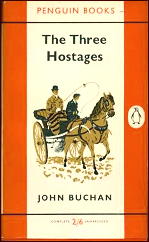
One evening the Hannays’ friend Dr Greenslade visits and their conversation turns to how to write a “shocker”. Dr Greenslade’s theory is the author should take three apparently unconnected things, invent a connection, and dream up a problem to solve involving the connection. His example: “an old blind woman spinning in the Western Highlands, a barn in a Norwegian sæter, and a little curiosity shop in North London kept by a Jew with a dyed beard.”
In the real world ugly international doings are afoot and eventually they intrude into Hannay’s household. Members of the families of three great men — “the daughter of the richest man in the world, the heir of our greatest dukedom, the only child of a national hero” — have been kidnapped and are being held as hostages by a “combine” whose members are outwardly respectable but which is using the disaffected across Europe and elsewhere to further their own concerns, including fraud, profiteering, and even murder.
Though known to the authorities, if members of this combine are captured too soon, the hostages will doubtless be executed and certain delicate political matters in the balance upset.
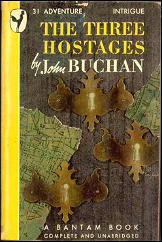
By a twist of fate Dr Greenslade’s literary example serves to aid Hannay and his friends get on the track of the villains in a race against a deadline at which they can only guess.
My verdict: Was Buchan following Dr Greenslade’s advice, I wonder? Hannay has quite a puzzle to solve and the first half of the book follows his attempts to make sense of the sole clue: six lines of doggerel sent to each of the three great men.
There is more intelligence work and less physical action in this novel and the slow working-out of the mystery is convincing. Mary Hannay, while mostly off the page, plays a role near the end that is both gripping and believable and received a loud hurrah from here!
Etext: http://gutenberg.net.au/ebooks03/0301231.txt
Editorial Comment: Shown below is Stob Ban in the Mamores, one of the peaks that might have been used as a model by John Buchan. For more mountain scenes and commentary on where they might have shown up in Buchan’s work, go here.
Mon 12 Apr 2010
A TV Review by MIKE TOONEY:
“The Trains of Silence.” An episode of Kraft Suspense Theatre (Season 2, Episode 28). First air date: 10 June 1965. Jeffrey Hunter, Tippi Hedren, Warren Stevens, Lloyd Bochner, Patrick Whyte, Francis DeSales, Dale Johnson. Teleplay: William Wood. Story: Ben Maddow. Story consultant: Anthony Boucher. Director: Douglas Heyes.
Fred Girard (Jeffrey Hunter) storms into a hotel demanding to see the man who lives in the penthouse, his old college friend Wolfe Hastings (Lloyd Bochner).
Fred is a Canadian geologist who has made a huge discovery: mineral deposits laced with titanium ore worth a cool three million dollars at current assay rates. He needs Wolfe, a reclusive multimillionaire, to finance development. All he wants is to see Wolfe, but he gets stonewalled from the get go, first by Wolfe’s alcoholic personal secretary Lee Anne (Tippi Hedren) and later by Wolfe’s righthand man, Mark Wilton (Warren Stevens).
The D-Day invasion of Normandy proved easier than getting in to see Wolfe. Fred’s initial attempt to penetrate Wolfe’s lair nearly gets him killed. When that fails, Wilton tries to buy him off with a $3 million check — provided he leaves town to cash it. Fred accedes at first, but then has second thoughts. Now he wants to see Wolfe more than ever.
With the unwilling assistance of an alley cat, at long last Fred breaks through the wall of security surrounding Humpty Dumpty and all the king’s men and discovers an ugly secret about his old college chum.
Unfortunately for Fred, he’s the one — and not Humpty — who’s been chosen to take the fall — from a rooftop sixteen floors up ….
This is Jeffrey Hunter’s show: He dominates every scene he’s in, and he’s in every scene. The script is already sharp, but Hunter improves on it. Tippi Hedren was a Hitchcock “discovery,” with The Birds (1963) being her first big starring role, followed by Marnie (1964).
Warren Stevens has often played villains. A few of his crime drama credits: Phone Call from a Stranger (1952), Gorilla at Large (1954), Black Tuesday (1954), Women’s Prison (1955, reviewed here ), The Price of Fear (1956), Accused of Murder (1956), Intent to Kill (1958).
TV credits for Stevens include two episodes of Checkmate, four appearances on Hawaiian Eye, three Kraft Suspense Theatre‘s (including “One Tiger to a Hill,” reviewed here ), Madigan (1968), and four episodes each of Mission: Impossible and Ironside.
Mon 12 Apr 2010
Reviewed by DAVID L. VINEYARD:
ALLAN GUTHRIE – Slammer. Houghton Mifflin Harcourt, US, hardcover, November 2009. Mariner Books, trade ppbk, September 2010. First Edition: Polygon, UK, softcover, March 2009 (shown).
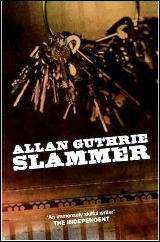
This is a tough minded noirish thriller from British writer Allan Guthrie, who has previously been nominated for the Debut Dagger from the British Crime Writer’s Association and won Theakston’s Old Peculiar Crime Novel award for Two Way Split. His novel Kiss Her Goodbye was nominated for an Edgar and an Anthony.
The man has some credentials for writing his particularly bleak version of the British crime novel. And bleak it is. Compared to Guthrie, Jim Thompson and David Goodies were cockeyed optimists. This one is the literary equivalent of those mad British crime films like Lock Stock and Still Smoking Barrel, but that sort of thing works better on screen than in print.
Nick Glass is a prison guard at the ‘Hilton,’ a Scottish prison with a bad reputation, and between the inmates and his fellow officers he finds himself in a special hell caught between two equally brutal and dehumanizing forces.
You might expect this to develop in classic noir form of a ‘hero’ who stands up to and defeats the forces on both sides after a brutal and bloody struggle, but that isn’t where Guthrie is going, though at times it seems so.
Nick’s life takes an even worse turn when a group of cons in the prison uses outside pressure to threaten Nick’s wife and daughter to force him to do them a ‘favor’ on the outside.
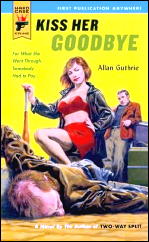
I’d like to quote from the book, but frankly there isn’t much that could be quoted here without heavy editing, and even then it wouldn’t give the feel of the book.
One problem I found with this is that I never cared what happened to Nick Glass. He’s an unappealing protagonist and it’s hard to care about his grim ironic fate. The novel takes a dark turn that I can’t discuss in fairness to Guthrie and anyone planning to read this, but I neither believed it nor felt he brought it off. I’m not sure any writer could bring it off.
Frankly I haven’t decided whether I like this or not. I’ll have to put it aside and come back in a different mood to be sure. The writing is assured and strong, but there is something about this book that made me feel like I needed to stop an take a shower when I finished it.
If the point of the book is that prison is a dehumanizing brutal place, I think most of us knew that going in. If it is that men break in strange ways I think we knew that too. And that’s the problem. I’m not sure exactly what Guthrie is trying to say, other than most of us would be better off to avoid a career in prison from either side of the law.
I suppose there is a certain black humor is watching Nick Glass shatter (sorry, couldn’t resist — and neither does Guthrie or the publisher), but for the life of me I can’t say I cared. He’s a singularly weak and unattractive character, and his attraction to a femme fatale named Lorna only makes him less appealing.
This type of book turns on the reader’s ability to identify with or at least emphasize with the protagonist’s grim predicament. In the case of Nick Glass I’m not sure his fate would have been much better if he had taken a job in the postal service or the mail room. He’s not merely a loser, but a high profile loser of the first order.
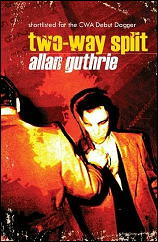
I don’t know where this book was supposed to take me. Where it did take me was to a depressing and bleakly unrelieved place with only a few grim moments of black humor to relieve the pressure — and I’m by no means certain they were even meant to.
Guthrie can write. No question there. And if you want a strong, even stomach churning crime novel with no redeeming characters or features and an outlook as bleak as the gray walls of a Scottish prison, then this is the book for you.
But I’ll have to be honest. I’m not sure if I would want to take this trip again, and when I do read a bleak novel of brutal crime I usually need some sort of cathartic release — even only a sort of grim irony or a satisfyingly operatic blood bath. I didn’t get that from this one, and that may be strictly me and where I am, but we all read books from that subjective point of view, and based on that, the most I can say is you’ll have to decide for yourself.
Ted Lewis’s Get Carter and Gerald Kersh’s Night in the City both did this much better and Georges Simenon’s Stain on the Snow showed us even the most unappealing protagonist could hold out attention. For that matter I can think of a half dozen stunning little British crime films from the last decade that all would be a better investment in time and money.
I wanted to like this one better. I went in expecting pretty much what I got, but I have to say that for me this one is an unappetizing and disappointing outing. That said, I’ll look up Guthrie’s previous novel and probably read his next. The talent is there if he can just tie it to some human element that we can identify with and care about.
I’m not sure Guthrie failed at what he sat out to do, only that he failed to make me care.
Bibliography: ALLAN GUTHRIE.
Two Way Split (2004)
Kiss Her Goodbye (2005)
Hard Man (2007)
Savage Night (2008)
Slammer (2009)
Killing Mum (2009)
Sun 11 Apr 2010
Those of you who are pulp collectors, and maybe even if you aren’t, you might want to take a look at a lengthy interview Laurie Powers did with Walker Martin on her blog, where many of the posts always seem to have something to do with either pulps or pulp collecting.
Walker, of course, is an occasional contributor and a frequent commenter here on the Mystery*File blog, as regular visitors already know. Over on Laurie’s blog, the primary topic of their question and answer conversation is “My Favorite Pulps,” referring to Walker’s collection, but that’s just the starting point.
Unfortunately Walker and I have known each other for 40 years, so I have to admit I knew all the answers he was going to give before he gave them, but it’s still interesting reading. Go, read, but do find your way back!
Sat 10 Apr 2010
Posted by Steve under
Reviews[5] Comments
THE BACKWARD REVIEWER
William F. Deeck
BELTON COBB – Murder: Men Only. W. H. Allen, UK, hardcover, 1962. No US edition.
Fearing that Detective Chief Inspector Cheviot Burmann is losing his grip on his job by not following up on information received, Woman Police Constable Kitty Palgrave takes it upon herself to investigate what might be going on at Mrs. Munro’s boardinghouse. This establishment is perhaps unique in that Mrs. Munro takes in only nonpaying male guests who she thinks might be lonely.
Taking leave from the police department, Palgrave gets herself employed as housemaid at the boardinghouse. Her main discovery there is the corpse of Burmann’s informant, a new inmate at the boardinghouse. When he becomes aware of Palgrave’s presence at the crime scene, Burmann comments: “As usual, you have wandered into one of my cases — and everything is considerably more complicated in consequence.”
Mrs. Munro is a dotty landlady, seldom finishing a sentence or a thought, and Burmann has trouble coping with her. Nonetheless, he clears up the crime in a tolerably amusing book.
There apparently is no such thing as a bad boardinghouse novel.
– From The MYSTERY FANcier, Vol. 13, No. 3, Summer 1992.
Editorial Comment: This is a scarce but not particularly valuable book. There are two copies in English (and two in French) to be found on abebooks, for example, and in neither case is the asking price over $20.
Cheviot Burmann was Cobb’s most commonly used series character, beginning with either No Alibi or The Poisoner’s Mistake, both of which came out in 1936 . A fellow named Bryan Armitage shared the billing in a few novels (including Murder: Men Only, although Bill did not happen to have mentioned it) plus had a few solo adventures on his own. Supt. Manning was the leading character in several more books.
She’s not mentioned in Al Hubin’s Revised Crime Fiction IV, but reading between the lines in Bill’s review, it’s all but certain that Constable Kitty Palgrave was in more than one of Inspector Burmann’s books as well.
Sat 10 Apr 2010
REVIEWED BY WALTER ALBERT:
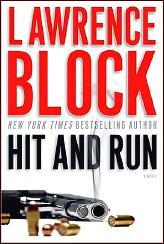
LAWRENCE BLOCK – Hit and Run. William Morrow, hardcover, June 2008. Harper, paperback, June 2009.
Block’s sympathetic hitman Keller returns for a fourth outing. As he’s waiting for the go ahead to carry out a job in Des Moines, a charismatic African-American governor is assassinated and a photograph of Keller is widely disseminated as the face of the assassin.
You might say that it’s poetic justice, but Keller’s been set up, and we always have the sense that the people who hire him are the real villains, with Keller the competent professional who’s just doing his job. His life in ruins, Keller goes on the run.
With the help of a new person who comes into his life and the ever faithful Dot, he eventually recovers but the momentum of the series has been seriously damaged. Much of the novel finds him just marking time, and that new person seems nothing more than a plot device to rescue Keller from an almost impossible situation.
As far as I’m concerned, this series has run its course, and if this is indeed meant to conclude Keller’s saga, it’s a lame resolution.
The Keller series —
1. Hit Man (1998)
2. Hit List (2000)
3. Hit Parade (2006)
4. Hit and Run (2008)
« Previous Page — Next Page »

